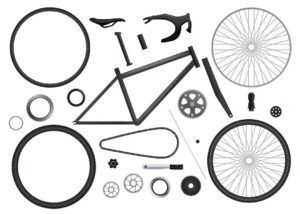ألياف الكربون خفيفة الوزن, قوي, ومواد متينة مصنوعة من خيوط رقيقة من ذرات الكربون. تشتهر بقوة الشد العالية والوزن المنخفض, مما يجعلها مادة مثالية لبناء إطار الدراجة. تسمح خصائص ألياف الكربون بإنشاء إطارات صلبة وسريعة الاستجابة توفر خصائص نقل الطاقة والتعامل معها ممتازة. في هذه المقالة, سنستكشف الأنواع المختلفة من ألياف الكربون المستخدمة في إطارات الدراجات, خصائصهم, فوائد, والعوامل التي يجب مراعاتها عند اختيار واحد مناسب لاحتياجات ركوب الدراجات الخاصة بك.

ألياف الكربون عالية الجودة
ألياف الكربون عالية الجودة هي أقسى وأقوى نوع من ألياف الكربون المتاحة. وهي تتألف من ألياف الكربون معبأة بإحكام, مما أدى إلى مادة مع صلابة متميزة والحد الأدنى من المرن. على المدى “عالي الجودة” يشير إلى ارتفاع مستوى الصلابة الذي أظهره هذا النوع من ألياف الكربون, مما يمكّنها من نقل الطاقة والاستجابة بسرعة لإدخال رايدر بكفاءة. يستخدم هذا النوع من ألياف الكربون بشكل شائع في الدراجات ذات الطرق العالية والدراجات الجبلية حيث تكون الصلابة والاستجابة حاسمة.
صفات
ألياف الكربون عالية الجودة, المعروف باسم ألياف الكربون عالية الجودة, تم تصميمه لتوفير صلابة وقوة استثنائية مع الحفاظ على ملف تعريف خفيف الوزن. إنه يتميز بنسبة منخفضة من الوزن إلى القوة ومقاومة عالية لقوى الانحناء واللف. إنه يوفر نقل طاقة ممتاز أثناء التداول ويضمن أقصى قدر من إخراج الطاقة مع تقليل المرونة والاهتزازات.
فوائد بناء إطار الدراجة
تزيد ألياف الكربون العالية في إطارات الدراجات الصلابة والاستجابة, جعل الإطار أكثر كفاءة في نقل قوة المتسابق إلى العجلات. هذا النوع من ألياف الكربون يعزز الأداء الكلي للدراجة من خلال توفير قدرات تسلق متفوقة وتحسين التعامل مع السرعات العالية. بجانب, إطارات مصنوعة من هذا النوع من ألياف الكربون تظهر الحد الأدنى من فقدان الطاقة أثناء التنقل, السماح لراكبي الدراجات بتحقيق أقصى قدر من الكفاءة والسرعة. إن أدائها في دقة المنعطفات والتعامل بشكل عام يجعلها مثالية للسباق التنافسي وركوب الأداء الموجهة نحو الأداء.
الألياف الكربونية الوسيطة
ألياف الكربون الوسيطة modulus هي نوع من المواد المركبة المشهورة بتوازنها بين الصلابة والامتثال. إنه يوفر مستوى معتدل من الصلابة مع الاستمرار في توفير درجة من الاهتزاز, مما أدى إلى تجربة ركوب مريحة ولكنها مستجيبة. يوجد هذا النوع من ألياف الكربون بشكل شائع في التحمل والدراجات على الطرق الشاملة حيث الراحة والأداء مهمان بنفس القدر من الأهمية.
صفات
تشتهر ألياف الكربون الوسيطة بنسبة معتدلة للوزن إلى القوة وقدرتها على رهيبة الاهتزازات على الطرق. يوفر جودة ركوب سلسة ومريحة مع الحفاظ على صلابة كافية لنقل الطاقة الفعال.
التطبيقات في إطارات الدراجات
تُستخدم ألياف الكربون الوسيطة بشكل شائع في إطارات الدراجات التي تركز على التحمل مصممة لركوب المسافات الطويلة والتضاريس الوعرة. على سبيل المثال, واحدة من إطارات الكربون المتميزة TP-140018. قدرتها على امتصاص اهتزازات الطرق تعزز الراحة أثناء ركوب الخيل الممتدة, تقليل التعب وتحسين جودة الركوب. بالإضافة إلى ذلك, توفر الإطارات المصنوعة من ألياف الكربون المتوسطة modulus مزيجًا من الكفاءة والراحة, جعلها مناسبة لمجموعة واسعة من تخصصات ركوب الدراجات.
ألياف الكربون القياسية
تتكون ألياف الكربون القياسية من polyacrylonitrile (مِقلاة) ألياف السلائف, التي يتم غربرة في درجات حرارة عالية لإنشاء ألياف الكربون النقي. إنه يوفر صلابة جيدة بينما يظل بأسعار معقولة نسبيًا مقارنة بالمتغيرات العالية. بسبب قدرتها على تحمل التكاليف, لقد أصبح الخيار الشائع للعديد من مصنعي إطارات الدراجات.
يتم استخدام ألياف الكربون القياسية عادة في أنماط إطار الدراجات المختلفة, من دراجات الطرق المبتدئين إلى الدراجات الجبلية الراقية. يوفر نقل الطاقة والاستجابة ممتازة, مما يجعلها مناسبة لراكبي الدراجات الترفيهية والمتحمسين الذين يبحثون عن إطارات موجهة نحو الأداء دون علامة سعر مميزة.
صفات
تتميز ألياف الكربون المعيارية بسهولة الإنتاج وسهولة الوصول إليها. إنه يوفر تصلبًا كافيًا لمعظم الدراجين بينما يكون أكثر تسامحًا من حيث جودة الركوب مقارنة بألياف الكربون عالية الجودة.
الاستخدامات الشائعة في تصنيع إطار الدراجة
تستخدم ألياف الكربون القياسية على نطاق واسع في دراجات الطرق المبتدئة, دراجات ركاب, والدراجات الجبلية الترفيهية. على الرغم من أنها ليست قاسية مثل ألياف الكربون عالية الجودة, لا تزال ألياف الكربون المعيارية توفر نقلًا ممتازًا واستجابة للطاقة. إنه يوفر مزيجًا جيدًا من الأداء والقدرة على تحمل التكاليف لراكبي الدراجات الذين يبحثون عن إطار خفيف الوزن ودائم دون كسر البنك.
فوائد أنواع ألياف الكربون المختلفة في إطارات الدراجات

يوفر كل نوع من ألياف الكربون المستخدمة في إطارات الدراجات مزايا فريدة مصممة لتفضيلات ركوب مختلفة وأهداف الأداء. دعونا نستكشف فوائد العالية, الوسيطة الوسيطة, وألياف الكربون القياسية في بناء إطار الدراجة.
زيادة صلابة للتسلق
ألياف الكربون عالية الجودة تعزز الصلابة والصلابة في إطارات الدراجات, جعلهم أكثر استجابة أثناء جهود التسلق. تتيح زيادة نقل الطاقة وكفاءة الدواسة للدراجين معالجة المنحدرات الحادة بسهولة وسرعة أكبر.
امتصاص الصدمات المحسّن
توفر ألياف الكربون المتوسطة الوسيطة امتصاص الصدمات وخصائص تخطي الاهتزاز, مما أدى إلى رحلة أكثر سلاسة وأكثر راحة. يساعد هذا النوع من ألياف الكربون على تقليل التعب والانزعاج أثناء ركوب الخيل الطويلة على التضاريس الوعرة أو الأسطح غير المستوية.
تحسين الديناميكا الهوائية
توفر ألياف الكربون المعيارية من ألياف الكربون خصائص ديناميكية جيدة تساعد على تقليل مقاومة الرياح وتحسين السرعة الكلية. يتيح التصميم المبسط لإطارات الدراجات المصنوعة من ألياف الكربون القياسية مع تدفق الهواء الفعال والأداء المعزز في أحداث ركوب الدراجات التنافسية.
العوامل التي يجب مراعاتها عند اختيار ألياف الكربون لإطارات الدراجات
عند تحديد مصادر إطارات ألياف ألياف الكربون من أفضل مصنعي إطارات الكربون الصينية مثل تألق قريبا, هناك عدة عوامل تلعب دورها لضمان تجربة الركوب المثلى. فهم هذه الاعتبارات الرئيسية, مثل الوزن, صلابة, والقوة, ضروري لاتخاذ قرار مستنير.
وزن
تعتبر ألياف الكربون عالية الجودة هي أخف الخيار المثالي للركاب الذين يعطيون أولوية أداء التسلق والتسارع ولكنه قد يأتي بتكلفة أعلى, في حين أن ألياف الكربون القياسية من الألياف الزمنية توفر توازنًا جيدًا بين الوزن والقدرة على تحمل التكاليف. لكن, من الضروري تحقيق توازن بين الوزن والمتانة, لأن الإطارات الخفيفة المفرطة قد تضحي بالقوة وطول العمر.
صلابة
تؤثر صلابة إطار ألياف الكربون بشكل مباشر على خصائص نقل الطاقة والتعامل معها. توفر إطارات ألياف الكربون عالية الجودة أعلى مستوى من الصلابة, توفير تجربة ركوب سريعة الاستجابة وفعالة. لكن, الدراجين الذين يفضلون أكثر سلاسة, قد تختار المزيد من الركوب الامتثال للإطارات التي تم إنشاؤها باستخدام الألياف الوسيطة أو الألياف الكربونية القياسية.
قوة
في حين أن جميع أنواع ألياف الكربون تقدم نسبًا استثنائية للوزن, عادةً ما توفر ألياف الكربون عالية الجودة أعلى مستوى من قوة القوة والتأثير. قد يستفيد الدراجون الذين يشاركون في أساليب ركوب عدوانية أو يشاركون في السباقات التنافسية من المتانة الإضافية لإطارات ألياف الكربون عالية الجودة. في حين أن ألياف الكربون المتوسطة والمعيارية توفر قوة كافية لمعظم احتياجات ركوب الدراجات الترفيهية والتنافسية.
خاتمة
ختاماً, يؤثر اختيار ألياف الكربون بشكل عميق على أداء وسمات إطارات الدراجات. سواء كان الهدف من الصلابة المتزايدة للتسلق, امتصاص الصدمات الفائق للراحة الدائمة, أو الديناميكا الهوائية المعززة للركض, أنواع مختلفة من ألياف الكربون المستخدمة في إطارات الدراجات تلبي متطلبات متنوعة. من خلال تقييم العوامل مثل الوزن, صلابة, والقوة, يمكن لراكبي الدراجات تحديد إطار ألياف الكربون المثالي لرفع تجربة ركوبهم.

















